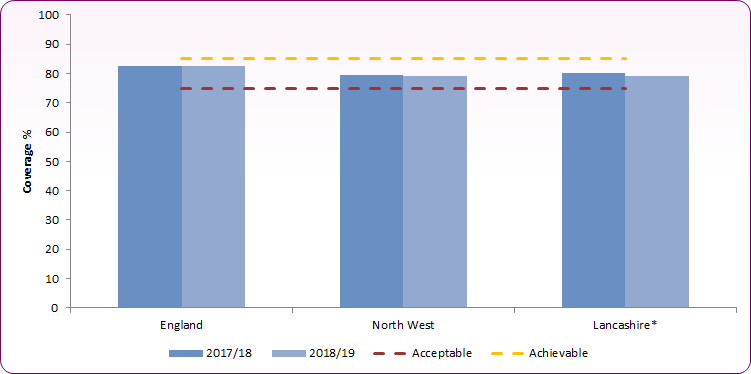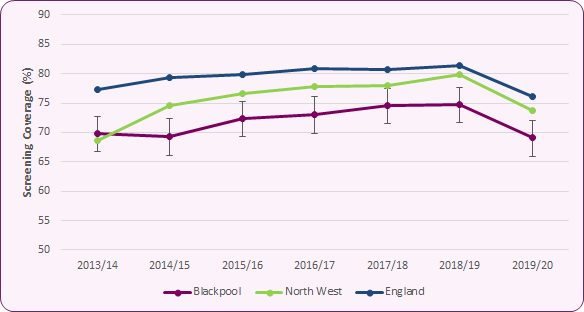Adult screening programmes
Last Modified 27/03/2023 14:12:05
Share this page
Introduction
Screening is an activity which identifies apparently healthy people from a defined population who may be at increased risk of a disease or condition. The idea behind screening is early detection of risk factors or early disease; beneficial for both clinical and health outcomes for a population. The non-cancer screening programmes delivered by the NHS are:
The NHS offers a range of free health checks such as the NHS Health Check and NHS screening programmes which are designed to spot early signs of certain diseases or see how likely you are to develop them. Cancer screening information is available in the breast cancer, cervical cancer and colorectal cancer sections of the JSNA.
Facts and figures
Diabetic retinopathy is one of the most common causes of sight loss among people of working age. It is is caused by high blood sugar levels damaging blood vessels in the eye. They may become blocked, have excess fluid or leak, causing blurred visions, and in worst case, blindness.
Diabetic eye screening seeks to reduce the risk of sight loss amongst those with diabetes by early identification and treatment of diabetic retinopathy. The programme is offered every year to all people over the age of 12 who have been diagnosed with diabetes. The screen involves a digital photograph of the retina (back of the eye) followed by a two- or three- image grading process, identifying any changes in the retina. Risk factors are continued high glucose levels, blood pressure, fatty foods and smoking. Regular screening allows prompt identification and effective treatment, if necessary, of sight threatening diabetic retinopathy. The NHS Diabetic Eye Screening Programme (DESP) is essential for identifying retinopathy at an early stage.
Diabetic eye screening services in Blackpool were provided by the Cumbria, North Lancashire, Blackpool, Fylde and Wyre Screening Programme, before joining the Lancashire-wide DESP programme in April 2017 provided by Emis Care. From April 2019, East Lancashire Hospitals NHS Trust became the new provider for DESP across Lancashire. Figure 1 shows the coverage (proportion of eligible people screened within the relevant time scale) of diabetic eye screening across Lancashire for the 2017 to 2019 period.
Figure 1:Diabetic eye screening coverage across Lancashire, 2017-2019
 Source: PHE, NHS Screening Programmes: KPI reports 2017/18 to 2018/19
Source: PHE, NHS Screening Programmes: KPI reports 2017/18 to 2018/19
While some people with diabetes may choose to decline an offer of screening, the level of uptake is an important measure of programme performance. Low uptake may indicate that:
- those offered screening are not accepting the test (for example, because they do not understand its importance, or because it is inconvenient, or because they have had a bad screening experience in the past), or
- those accepting the test are not being tested (for example, because they attend but do not receive screening by digital photography)
Diabetic eye screening data was previously collected as part of the Quality and Outcomes Framework (QOF) and figures for 2013/14 show that 82.4% (8,420) of people in Blackpool who have been diagnosed with diabetes had an eye screen in the previous 12 months. This is the same as the national average. Diabetic eye screening is not part of the QOF now due to the national screening programme, and specific Blackpool coverage figures are not currently available*.
For further information on sight loss or diabetes see the Eye Health and Sight Loss and Diabetes sections.
The NHS AAA Screening Programme aims to reduce deaths from the condition among men aged 65 and over by up to 50 per cent by detecting aneurysms early and offering appropriate monitoring or treatment. Men aged 65 and over are most at risk from the condition and invitations for screening are sent to men in Lancashire and South Cumbria in the year they turn 65.
The programme began rollout across Lancashire and Cumbria in 2013. Figure 2 shows the coverage (percentage screened of those eligible for an initial screen) across Blackpool, the North West and England.
Data for Blackpool shows that in 2019/20:
- Of 851 eligible males, 588 (69.1%) were screened, significantly lower than the national average of 76.1%.
- The Blackpool screening rate has been significantly lower than the national average each year since the programme commenced, but had been rising steadily until 2019/20.
- 5.9% of men (50 out of 850) declined screening for AAA compared to the England average of 3.4%. This is a similar rate to 2018/19.
Note: 2019/20 data partially covers the time period through the COVID-19 pandemic and therefore should be interpreted with caution.
Figure 2: AAA Screening Coverage: Blackpool, the North West and England 2013/14 to 2019/20 Source: PHE, Public Health Profiles
Source: PHE, Public Health Profiles
Scans which identify a small (3.0-4.4cm) or medium (4.5-5.4cm) aneurysm won't need any treatment at this stage but will be monitored in case it gets bigger. Because aneurysms grow so slowly, men with a small or medium aneurysm may never need treatment. An AAA 5.5cm or larger will lead to a referral to a vascular surgeon who may recommend an operation.
Screening programme data from 2019/20 shows that 1.02% (6 out of 588) of men screened in Blackpool were identified with an aorta of 3cm or larger, in comparison to an England average of 0.92%. In 2018/19 (pre-COVID data), 1.44% were identified with an aorta 3cm or larger, compared to 0.97% nationally1.
Risk factors for an AAA
It's not known exactly what causes the aortic wall to weaken, although increasing age and being male are known to be the biggest risk factors. One study found that people aged over 75 are seven times more likely to be diagnosed with an AAA than people under 55 years old. Men are around six times more likely to be diagnosed with an AAA than women2.
However, there are other risk factors that you can do something about – the most important of which is smoking.
National and local guidance
An overview of the NHS diabetic eye screening programme, its services, and contact information
The Royal College of Ophthalmologists Diabetic Retinopathy Guidelines provide evidence-based, clinical guidance for the best management of different aspects of diabetic eye disease.
How the NHS abdominal aortic aneurysm screening-programme works: who is eligible, what it does, how to find out more
Public Health England, Abdominal Aortic Aneurism Screening: standard reports 2019 to 2020 and 2018 to 2019
NHS Choices, Abdominal aortic aneurysm